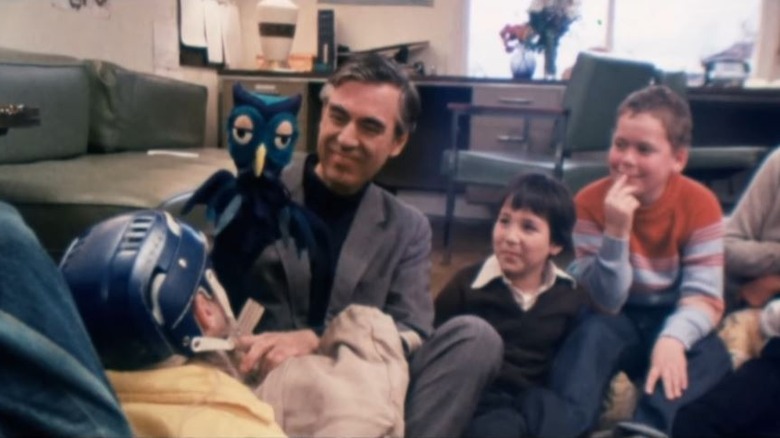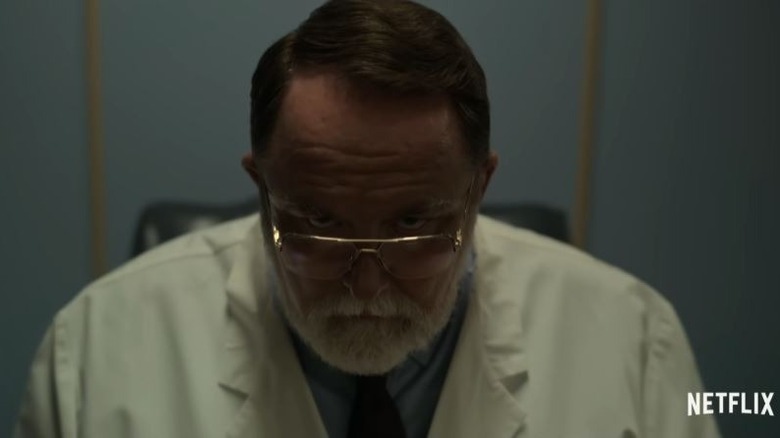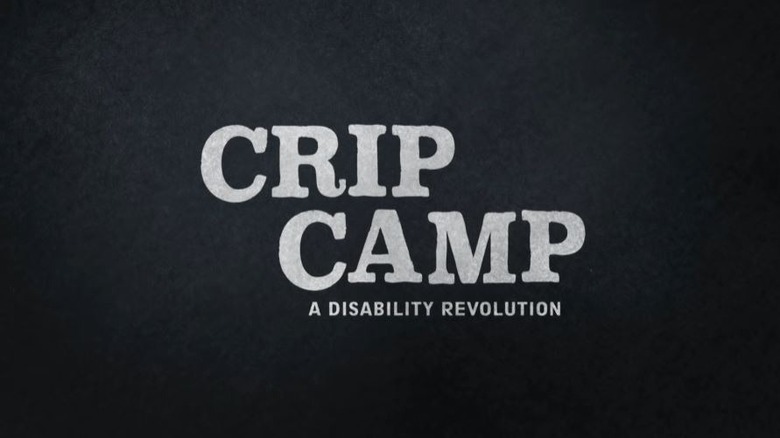The 11 Best Documentaries You Can Watch On Netflix Right Now
When we turn on our TV screens or engage with media in nearly any form, we expect it to exist within one of two camps. There is fiction spun up by a writer or a team of writers, which take us to far-off lands where people are smarter, braver, and cleverer. And there is non-fiction, like your nightly news reports, which endeavor to report the facts. Documentary exists somewhere in the middle, using archival or original footage and witness or expert testimony to tell a narrative story through an interpretation of real events.
Documentaries are not always the most glamorous genre of filmmaking, but they can be among the most illuminating. Through the right lens, talented documentary storytellers can take otherwise mundane human stories (and sometimes non-human stories) and elevate them to the height of our most enduring legends.
Ordinary individuals become heroes and villains inside of their own stories and we get a window into the everyday activities which might otherwise go unseen in an increasingly crowded world. From intimate stories of personal lived experiences to wide-reaching tales that changed the course of the world, these are some of the best documentaries you can watch on Netflix right now.
The Pez Outlaw
Pez — a stylized shortening of pfefferminz, the German word for peppermint — started out as a candy offered in rolls or tins in Vienna, Austria, circa 1927. In the early days, they were marketed as an alternative to smoking. Even the long, slender design of the dispenser arose from an attempt to mimic the look and feel of a lighter. When the candy made its way to the United States in 1952, the company quickly added heads to the dispensers and started marketing them toward kids. Those heads also spawned a robust collector community.
Steve Glew started collecting Pez in the '80s, during a time when dispensers were region specific. At the height of the Pez craze, Glew realized an opportunity to turn a profit by getting rare dispensers from Europe and selling them on the secondary market back home. Becoming the leading force in Pez dispenser redistribution made him a hero among collectors; it also made him public enemy number one in the eyes of Pez Candy USA president, Scott McWhinnie, otherwise known as the Pezident.
Among other duties, McWhinnie was responsible for deciding which dispensers were released in the United States and he didn't take kindly to Glew cutting in on his turf. What follows in "The Pez Outlaw" is a tale with all of the intrigue of smuggling illegal contraband across international borders but with much goofier stakes.
Won't You Be My Neighbor
As the name suggests, "Won't You Be My Neighbor" tells the story of Fred Rogers — That's Mister Rogers, to you — and the way he changed the world through radical kindness. The documentary starts at the show's beginning in 1968 and follows the evolution of the program through several decades and into the nascent years of the 21st Century.
Unlike other documentaries of its kind, "Won't You Be My Neighbor" doesn't go digging for scandals and doesn't spend much effort trying to peel back the curtain to reveal the "real" Fred Rogers. Instead, it focuses on the character of Mister Rogers, if it was indeed a character, and the impact Rogers had on generations of kids.
While parents and teachers covered the material in the textbooks, Mister Rogers talked directly to children, through their television sets, about things other adults often wouldn't. He spoke to us about our feelings, where they come from, and how to manage them. He was teaching kids emotional literacy at a time when those weren't buzzwords anyone had heard. More than that, he offered a model for how to be a person that feels revolutionary, even half a century after it first aired.
13th
This 2016 documentary from Ava Duvernay ("Selma") takes its name from the 13th Amendment to the United States Constitution, which ostensibly abolished slavery. Of course, the amendment makes an important exception regarding the practice of slavery or involuntary servitude. The amendment states, in full, "Neither slavery nor involuntary servitude, except as a punishment for crime whereof the party shall have been duly convicted, shall exist within the United States, or any place subject to their jurisdiction."
The exception left as punishment for a crime is the sticking point of "13th." Before the credits roll, it makes a compelling argument that slavery never really ended in the United States and is perpetuated even today, through the criminalization of specific behaviors and groups of people.
The documentary focuses largely on the prison industrial complex in the United States, and the way it is designed from the ground up to funnel marginalized groups, particularly black, brown, and indigenous people, into the prison system. And it asks a question that demands an answer: If slavery never really ended can anyone, most especially vulnerable groups and individuals, ever really be free?
Night on Earth
You may have seen plenty of nature documentaries before, but you've never seen anything quite like this. "Night on Earth" is a Netflix original nature documentary that, as the name suggests, focuses on the night-time activities of nocturnal animals. Already, that means you're going to see some animals and some activity you might not have seen before, but "Night on Earth" stands apart because of its reliance on cutting-edge low-light camera technologies.
The pupils in your eyes do a pretty good job of adjusting to changing light conditions but they have their limits. When the amount of light drops too low, you might as well have your eyes closed for all the good they're doing. Cameras, however, don't have those same limitations, offering a view of the world that is usually hidden from us.
The views are almost otherworldly as stars twinkle in well-lit, faintly purple skies. Scenes appear cast in shadow and fully illuminated all at the same time. It's the sort of thing that almost defies description and leaves you feeling like an unseen witness to a party you weren't even supposed to know was happening. It's a side of the world you just have to see.
Our Father
Getting all of your siblings around a dinner table can be challenging even in the best of times. Everyone has lives of their own and balancing a handful of schedules is never easy. For one unconventional family, the biggest challenge to a family dinner is finding a table large enough. "Our Father" explores the activities of one Dr. Donald Cline, a fertility specialist previously operating in Indiana.
For the nearly 10 years Cline was in practice, countless people walked through his doors and left pregnant. That's not the problem, it was a fertility clinic after all, but each of them believed their child to be the product of their egg and sperm from a donor or from a partner. In reality, Cline was using his own sperm to impregnate people without their knowledge or consent.
What Cline didn't anticipate was the advent of affordable, accessible, and easy-to-use home DNA kits. When one of his children used a 23andMe home DNA kit and discovered several half-siblings spread throughout the country, a genetic fraud years in the making began to unravel. "Our Father" is at once a story of betrayal and of finding family under the most unusual circumstances.
David Attenborough: A Life on Our Planet
David Attenborough has spent his life championing natural spaces and conservation efforts. Along the way, through his documentary work in films and series like the acclaimed "Planet Earth," Attenborough has almost become the voice of nature itself. Over the course of more than 60 years, Attenborough has contributed to more than 100 documentaries, earned dozens of awards for science communication, and has at least 20 species named for him.
"David Attenborough: A Life on Our Planet" turns the lens inward to look at the life of the man who gave voice to the wilderness. Attenborough narrates the documentary himself and calls the work his witness statement for the environment.
In much the same way that Attenborough might narrate the activities of a field mouse or a mother polar bear, he examines his own life, sampling through the greatest hits of his 60-year career as a naturalist and host. Through the course of a lifetime devoted to nature, Attenborough has witnessed dramatic changes to natural landscapes all over the world, to a degree that few other people have. And he knows more than most about the cost that comes due when nature is lost. Attenborough has been banging the drum for conservation for the better part of a century and he seems determined to take every last opportunity to keep doing just that, even if it means a little bit of naval gazing.
The Last Dance
In the 1990s, even if you weren't particularly interested in sports, you knew about Michael Jordan and the Chicago Bulls. Jordan did things on the court that didn't seem human, shifting his body in mid-jump and deftly dancing the ball around his opponents. Of course, despite the popular narrative, Jordan wasn't a one-man show and that is one of the central focuses of "The Last Dance."
It explores the runaway train that was the Chicago Bulls in the '90s — during which they won six championships in eight years — while taking a special focus on the 1997 – '98 season, Jordan's last season with the team. It's the story of a group of people at the height of their game and all of the baggage that brings with it.
"The Last Dance" plays out over the course of 10 episodes and includes interviews with dozens of people who were there at the time. It also benefits from a trove of contemporaneous footage — the Bulls offered nearly open access to cameras during the '97 – '98 season for filmmakers to pull from — and hours of exclusive interviews with Michael Jordan himself. While there's plenty for the sports fans out there, it's also an interesting examination of the unique pressures that come with being one of the most famous people on the planet.
Crip Camp: A Disability Revolution
Countless young people have returned home from summer camp feeling like the experience changed their lives. For many, those feelings fade as we return to our normal routine and the magic of camp is replaced with the reality of home. For some people, however, camp really does change the world.
The year is 1971 and the place is Camp Jened, a summer camp in New York aimed at young people with disabilities. It's immediately clear from the smiling faces and firsthand testimony that these kids, forced to exist in a world that isn't built for them, find freedom and connection at camp. At camp, the disabilities don't disappear, nor do the challenges that come with them, but the stigma goes away — and that's worth a lot.
The story of the camp itself might have been enough for a compelling documentary, but it's what those kids did after camp that got them into the history books. The relationships established at Camp Jened would go on to define the American disability rights movement in the 1970s when several of the campers became prominent activists for a national movement.
Pepsi, Where's My Jet?
The soda wars between Coke and Pepsi have been raging for decades but some battles are more interesting than others. In the '90s, having realized that Coke had a lock on the older generations, Pepsi started courting the youth of America with bombastic ads filled with beautiful people. The message being that Coke was your dad's drink and Pepsi was the choice of a new generation.
In an attempt to appeal to young people, Pepsi launched its Pepsi Stuff campaign. Cans and bottles of Pepsi (or other Pepsi-branded consumables) came with point values printed on their labels. Consumers could clip the points, toss them in an envelope with an order form and some postage, and exchange those points for branded swag. Today, everyone offers a loyalty program but in the era of Pepsi Stuff, this was a novel consumer relationship. This is probably why Pepsi made a pretty predictable error: Underestimating the youth of America's desire for free stuff.
In an advertisement promoting the campaign, Pepsi advertised various products you could claim via Pepsi Points. Options included things like sunglasses, leather jackets, and, at the end of the commercial, a Harrier jet redeemable for 7 million points. That's when John Leonard, then a college student in Oregon, cooks up a scheme to get himself a military aircraft, courtesy of Pepsi Co. Leonard gets more than he bargained for, even if he never does get that jet.
Stay on Board: The Leo Baker Story
Leo Baker started skating professionally in 2000, at the age of only nine years old. At the time, skating was experiencing something of a revolution, thanks in no small part to the popularity of "Tony Hawk's Pro Skater" which had been released the previous year. A lot has changed for Leo Baker over the past 20 years, including his name, gender, and relationship with skating.
Early in Leo's career, when he still presented as female, he was seen as a potential poster child for girls in skateboarding. That's something that would define much of Leo's career, while he was quietly trying to navigate his own gender identity in the background. All of that came to an inflection point in 2020 when the Winter Olympics in Tokyo were set to host the first-ever US women's team for skateboarding and Leo qualified for the team. He had a choice, to live out a lifelong dream of competing at the highest level of the sport or give that up for a chance to live authentically, even if it meant losing everything he had worked for.
Five Came Back
"Five Came Back," based on the book of the same name, takes a close look at the ways in which warfare and movies intersected during the second world war. At the time, news about the ongoing global conflict came primarily from footage played before movies at the theater. That footage was gathered under the direction of five prominent filmmakers from the time — John Ford, William Wyler, John Huston, Frank Capra, and George Stevens — who took their cameras to the frontlines to document combat.
Their work is analyzed by five modern filmmakers — Paul Greengrass, Steven Spielberg, Francis Ford Coppola, Guillermo del Toro, and Lawrence Kasdan — and narrated by Meryl Streep. While historians might have provided context about the setting, the panel of filmmakers are able to shed light on the possible motivations behind creative choices, which is infinitely more interesting. Through their examination and expert commentary, viewers get a window into the ways cinema shaped the popular view of the war and our place in it. We also see the ways in which the filmmakers at the front were changed by what they were seeing through the lens.
For maximum context, Netflix has also added all of the propaganda films referenced in the documentary, under the title "Five Came Back: The Reference Films."











